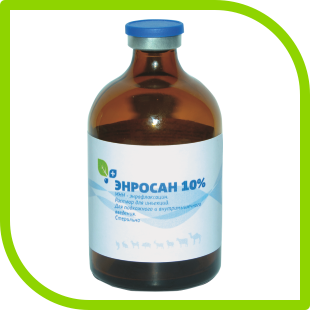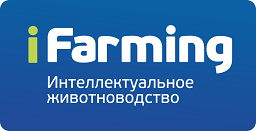
INSTRUCTION
on the use of Enrosan 10% solution for injection
for the treatment of diseases of calves and pigs of bacterial etiology
(Organization-developer: LLC Firm “Biochempharm”, Raduzhny, Vladimir region.)
I. General information
1.Trade name of the drug: Aquasan 10% solution for injection (Enrosan 10% solutio pro iniectio).
International nonproprietary name: enrofloxacin (Enrofloxacin).
2. Dosage form: solution for injection. In 1 ml of the solution contains 100 mg of enrofloxacin and excipients. In appearance, the drug is a transparent solution of light yellow color.
Enrosan 10% solution for injection is available sterile packaged in 10, 50 and 100 ml in glass or polymer bottles, capped with rubber stoppers, reinforced aluminum caps. Other packing agreed in accordance with the established procedure is allowed.
3. Shelf life of the drug under storage conditions-3 years from the date of release. Do not use the medicine after its expiration date.
4. The drug is stored in a dry, protected from light, at a temperature of 5°C to 25°C.
5. Enrose 10% solution for injection should be stored in places inaccessible to children.
6. Unused product with expired shelf life is disposed of in accordance with the requirements of the legislation.
II. Pharmacological properties
7. Pharmacotherapeutic group: antibiotic of the fluoroquinolone. Enrofloxacin, which is the active ingredient of Enrosan, inhibits the DNA gyrase of bacteria, thereby disrupting the process of DNA replication, as a result of which microorganisms can not reproduce. Enrofloxacin is rapidly absorbed into the blood and penetrates into all organs and tissues of the body. The maximum concentration of the drug in the blood is achieved after 1.5-2 hours and remains for 6 hours, and the therapeutic concentration – for 24 hours.
The drug is mainly excreted in the urine and bile.
Aquasana in combination with chloramphenicol, macrolides or tetracycline can be observed antagonistic effects.
Do not administer simultaneously with non-steroidal anti-inflammatory drugs and theophylline.
Enrosan 10% solution for injection according to the degree of impact on the body refers to moderately dangerous substances (hazard class 3 according to GOST 12.1.007-76), in recommended doses is well tolerated by animals, does not have a local irritant, does not have embryotoxic, teratogenic and hepatotoxic properties.
III. The order of application
8. Enrose 10% solution for injection is used for the treatment of infectious diseases of large and small cattle, camels and other ruminants (colibacteriosis, pasteurellosis, and salmonellosis, mycoplasmosis, clostridia, dysentery, leptospirosis), pigs (bacterial diseases of the gastrointestinal tract (Solidaria, colisepticaemia) and bacterial respiratory diseases and for the treatment and prevention of mastitis-metritis-agalactiae syndrome), rabbits (pasteurellosis, enterotoxemia, dysentery, Listeria rodents, etc.), fur animals and dogs (bacterial diseases of the digestive – intestinal tract and respiratory tract, leptospirosis) caused by the following gram-positive and gram-negative bacteria and mycoplasmas sensitive to enrofloxacin: E. coli, Haemophilus, Pasterella, Mycoplasma bovis, Staphylococcus, etc.
9. Enrosan 10% solution for injection is not allowed to be used in the following cases:
– for the treatment of females during pregnancy;
– with significant violations of the development of cartilage;
– with lesions of the nervous system, accompanied by convulsions;
– in the presence of microorganisms resistant to quinolones;
– together with nonsteroidal anti-inflammatory drugs;
– in case of individual hypersensitivity to the components of the drug;
– contraindicated in horses, especially during the development of the musculoskeletal system, as it causes changes in articular cartilage.
It is not allowed to use the drug in dairy animals in connection with its release with milk.
10. Before applying Aquasana necessary to check the sensitivity of pathogens to fluoroquinolones.
Enrosan 10% solution for injection is administered to ruminants, rabbits and carnivores intramuscularly or subcutaneously, and to pigs intramuscularly in doses: 2.5 ml per 100 kg of animal weight (2.5 mg of enrofloxacin per 1 kg of weight). The drug is prescribed to young ruminants once a day for 5 days in a row, to pigs for 3 days, and in the treatment of mastitis – metritis of agalactic syndrome of sows – for 1-2 days.
If after 3-5 days of therapy there is no clinical improvement, it is advisable to test microorganisms for sensitivity to fluoroquinolones or replace Enrosan with another antibacterial drug. In connection with the possible pain reaction, the drug should be administered in an amount of not more than 5 ml in one place to large animals, 2-3 ml to medium animals and not more than 1 ml to small animals.
11. When using Enrosan 10% solution for injection in accordance with this instruction, there are no symptoms of overdose.
12. Features of the drug at the beginning of use or when it is canceled is not revealed.
13. You should avoid skipping the next dose of the drug, as this can lead to a decrease in therapeutic efficacy. In the case of skipping one or more doses of the drug as soon as possible resume in the same dosage and according to the same scheme.
14. In some cases, after the use of Enrosan 10% solution for injection, a short-term violation of the function of the gastrointestinal tract is possible. Pigs can be expected to be local irritation of the tissue after injection. Have dogs small and medium-size breeds can cause changes in articular cartilage in age from 2 to 8 months, and have large breeds until 18 months. It is possible to develop degenerative changes in articular cartilage in horses, especially during the development of the musculoskeletal system.
15. The drug is not recommended for use simultaneously with bacteriostatic antibiotics (levomitsetinom, macrolides and tetracyclines), Theophilus and nonsteroidal anti-inflammatory drugs because of the possible antagonistic effect.
16. Slaughter for animal meat is allowed not earlier than 11 days after the last use of the drug. Meat animals, forced killed before the deadline, can be used to feed flesh eaters or for production of tankage.
IV. Personal prevention measures
17. When working with Enrosan 10% solution for injection should follow the General rules of personal hygiene and safety, provided when working with drugs. At the end of work hands should be washed with warm water and soap.
18. When working with the drug, it is forbidden to drink, smoke and eat. After working with the drug, wash your hands with soap and water.
19. In case of contact with the skin and/or mucous membranes, it is recommended to wash them with plenty of running water. In case of accidental ingestion – give the victim to drink a large amount of water (4-5 glasses) and cause vomiting. In case of allergic reactions, you should immediately contact a medical institution (you should have the instructions for use of the drug and the label).





